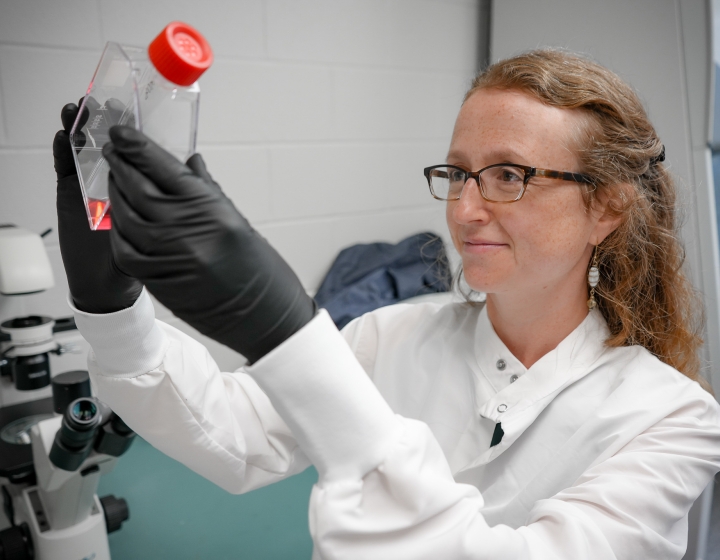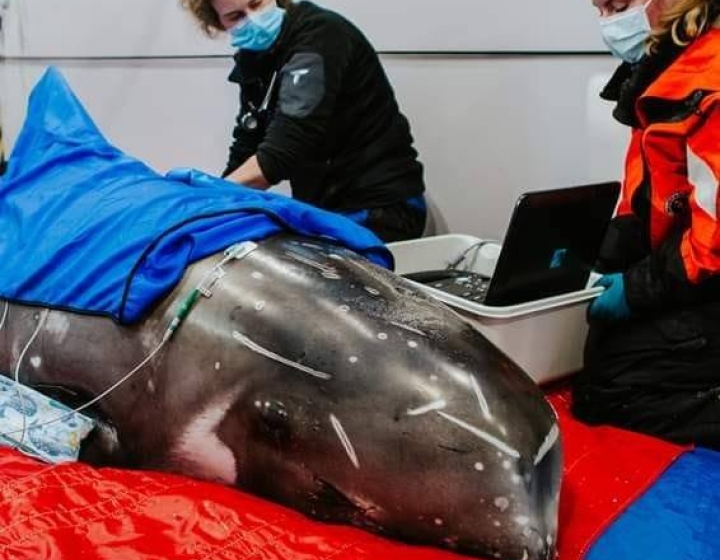How Studying Diseases in Dogs Can Help Prevent Future Human Epidemics
Note: This news item features content from another page. View the featured content for this news item.
How Studying Diseases in Dogs Can Help Prevent Future Human Epidemics
In 1978, dogs around the world began dying from parvovirus, a disease that was completely unknown before that time. In the 1980s, hundreds of thousands of people contracted a new and deadly virus, HIV. One thing these outbreaks have in common is that both viruses jumped from another animal into a new host. Parvovirus moved from a host related to cats, possibly to another wild animal, before infecting dogs. HIV circulated in chimpanzees before a person picked up the virus, which initiated the epidemic in humans.
Viruses have repeatedly found ways to infect and spread within new host species, whether in humans or other animals. Dr. Colin Parrish, the John M. Olin Professor of Virology at the Baker Institute is studying the ways that viruses, specifically parvovirus and influenza, have been able to move between different animal species and spread within dog populations. “The things we are learning about viruses in dogs have a basic application for understanding how a different virus might emerge in humans to cause an epidemic,” said Parrish. “There’s nothing special about infecting humans if you’re a virus.”
When studying global pandemics, dog viruses offer many advantages over human ones. Parrish’s lab members face a much lower risk of being infected by a canine virus. Since they are so widespread, his lab can receive samples from veterinarians and shelters, and observe a virus’ evolution while outbreaks are in progress. They can also look retroactively at how changes in a virus’ genetic code enabled the virus to jump to a new host species, and recognize the ways that it spread to explain new or worsening outbreaks.
Influenza is an excellent example of viruses that have moved repeatedly between animal species. The 1918 “Spanish Flu” that infected about one third of the world’s human population was initially a strain of avian influenza, while the 2009 H1N1 pandemic strain came from swine. Deadly but limited outbreaks of avian influenza also have occurred in people in many countries, but fortunately that virus does not yet pass easily between people, preventing the virus from becoming more widespread.
A different avian influenza virus transferred to dogs in Asia in 2005, and that was the cause of the canine influenza outbreak that occurred in the U.S. in 2015, after it was imported along with infected dogs from Asia. An earlier canine influenza outbreak in 2000 stemmed from an equine strain of the virus. That virus circulated in dogs in the U.S. for 15 years, but has mostly died out.
Oftentimes, viruses successfully jump to new host species when genetic changes enable them to gain entry to the new host’s cells and replicate themselves. For example, the parvovirus strain that killed so many dogs in the late 1970s originally was very similar to a feline parvovirus, but with mutations that changed the shape of its protein shell. Those changes allowed the virus to attach to and infect canine cells. Once it successfully infects the new animal, the virus may continue to evolve and adapt to the host to become more infectious.
Viruses must also overcome geographic barriers and other hurdles to establish themselves in a new population. In the 2015 outbreak of canine influenza in the U.S., dogs from Asia ended up at many shelters, which created multiple points where new dogs could be infected. That strain has also spread between dogs at doggie daycare facilities. “It’s these special chains of transmission that allow outbreaks to occur and be maintained,” said Parrish. His research can also inform ways to strengthen the barriers that stop transmission, such as better quarantine procedures for imported dogs, which may have averted this recent outbreak, and which can prevent future ones.
For known viruses like influenza and parvovirus, vaccinations can offer significant protection. But for viruses that have not yet made the jump, or have not caused a global outbreak, Parrish’s work can help us to identify viruses with pandemic potential and allow us to put into place stronger public health protections to prevent a virus’ spread. By understanding how and why outbreaks occur, the Baker Institute is helping to protect humans and our canine friends from emerging diseases.
Written by Patricia Waldron





